East Texas Gardening Blog 
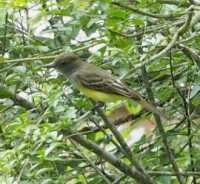 May 25, 2019 - The Great Crested Flycatcher - The other day I heard an unfamiliar bird call (actually from a small group of them) in my backyard. I tried in vain to spot them high up in the trees where they were flitting about. The call was so distinctive that I felt that it should be easily identified, so I took a short movie with my Olympus camera, extracted the audio and sent it to Cliff Shackleford, Texas Parks & Wildlife Non-Game Ornithologist. He quickly ID’d them as Great Crested Flycatchers. Later I was looking at some photos I took when I pointed my camera to where they had flown to but still did not see the actual bird. To my surprise, when I enlarged the photo, I got a fairly good, in-focus shot of one. (read more)
May 25, 2019 - The Great Crested Flycatcher - The other day I heard an unfamiliar bird call (actually from a small group of them) in my backyard. I tried in vain to spot them high up in the trees where they were flitting about. The call was so distinctive that I felt that it should be easily identified, so I took a short movie with my Olympus camera, extracted the audio and sent it to Cliff Shackleford, Texas Parks & Wildlife Non-Game Ornithologist. He quickly ID’d them as Great Crested Flycatchers. Later I was looking at some photos I took when I pointed my camera to where they had flown to but still did not see the actual bird. To my surprise, when I enlarged the photo, I got a fairly good, in-focus shot of one. (read more) August 4, 2018 - Super Sizzling Salvias for Hot Summer Color - Looking for plants that are beautiful to behold, yet tough as nails? Let me share with you some “sage” advice. If you have a sunny spot in your yard needing vibrant color spring through fall, consider growing salvia, also called sage. There are many that will easily fill the bill. And, if you’re like me with a yard that is part sun and part shade, there are salvias for you! One of the most diverse and useful groups of plants for a Texas landscape are the sages - botanically known as Salvia.
(read more)
August 4, 2018 - Super Sizzling Salvias for Hot Summer Color - Looking for plants that are beautiful to behold, yet tough as nails? Let me share with you some “sage” advice. If you have a sunny spot in your yard needing vibrant color spring through fall, consider growing salvia, also called sage. There are many that will easily fill the bill. And, if you’re like me with a yard that is part sun and part shade, there are salvias for you! One of the most diverse and useful groups of plants for a Texas landscape are the sages - botanically known as Salvia.
(read more) May 15, 2018 - Pipevine Swallowtails and Dutchman's Pipe - I really like all of the swallowtail butterflies. They are large, beautifully colored, graceful, and add so much interest to our gardens and environment. Many of the species are distinctively colored and marked so identification is unmistakable. Also, they all have particular requirements for larval host plants. The beautiful zebra swallowtail main larval host is pawpaw, while the giant swallowtail host are mainly members of the citrus family. The Pipevine Swallowtail butterfly (Battus phileno) larvae feed on Dutchman’s pipe or pipevine (Aristolochia spp.) These plants have unusual flowers that are in the shape of a pipe such as Sherlock might have used. (read more)
May 15, 2018 - Pipevine Swallowtails and Dutchman's Pipe - I really like all of the swallowtail butterflies. They are large, beautifully colored, graceful, and add so much interest to our gardens and environment. Many of the species are distinctively colored and marked so identification is unmistakable. Also, they all have particular requirements for larval host plants. The beautiful zebra swallowtail main larval host is pawpaw, while the giant swallowtail host are mainly members of the citrus family. The Pipevine Swallowtail butterfly (Battus phileno) larvae feed on Dutchman’s pipe or pipevine (Aristolochia spp.) These plants have unusual flowers that are in the shape of a pipe such as Sherlock might have used. (read more)- July 24, 2017 - Spider Mites on Tomatoes - There’s nothing like biting into a fresh, juicy, fully ripened tomato, right out of the garden. They are productive, fast-growing, and just a few plants, or even one, meet the needs of a typical family. No wonder they are one of the top vegetables grown in the home garden. But, unfortunately, production can be adversely affected by problems. (read more)
- July 19, 2017 - Start Fall Garden in July -
Mid-July means two things: the dog days of summer and fall vegetable gardens. Everyone can relate to dog days – it's hot and humid, good only for dogs to find a cool spot to dig a hole. But fall gardens? In July? That's right! Mid-Summer is the time to begin preparing and planting the garden for a fall harvest. (read more)
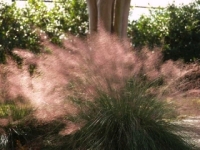
- December 19, 2016 - The Winter Landscape - Winter is not the most favorite time of year for most folks when it comes to gardening and enjoying your yard. The bright flowers of summer are a faded memory, fall tree colors have dropped to the ground, and the days grow shorter as we approach the winter solstice, bringing chilly, often damp, cloudy and dreary conditions. Yet, the changing seasons also bring about transformations in the yard and landscape that cannot be appreciated at other times of the year. (read more)
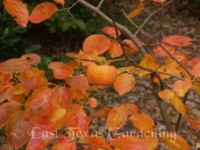
- December 4, 2016 - Oriental Persimmons for Beauty and Tasty Treats - Looking for an attractive and easy fruit tree for your yard? Try the oriental, Kaki or Japanese persimmon (Diospyros kaki). This handsome small tree is perfectly adapted to our area, relatively free of pests, easy to grow, and provides delicious and attractive fruit and colorful fall foliage ‑ what more could you want? Most folks don't notice oriental persimmons until the leaves have all fallen, revealing a bounty of bright orange globes hanging from the branches like ornaments. (read more)
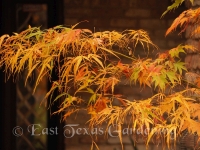 November 24, 2016 - Orange For Thanksgiving - Orange is such a fall color – probably most closely associated with pumpkins, and that favorite Thanksgiving desert, pumpkin and sweet potato pie (yes, pecan pie is also right up there in the favorite category). All the fruit off of my Satsuma tree has been harvested, ripening during the fall color fest. One of my other favorite fruits is Japanese persimmon, and they are indeed pumpkin orange, also ripening at this wonderful time of year. The color orange is not restricted to fruit, however, as several trees and shrubs have glowing orange foliage during this transition time from summer to winter. Here are a few favorites.
(read more)
November 24, 2016 - Orange For Thanksgiving - Orange is such a fall color – probably most closely associated with pumpkins, and that favorite Thanksgiving desert, pumpkin and sweet potato pie (yes, pecan pie is also right up there in the favorite category). All the fruit off of my Satsuma tree has been harvested, ripening during the fall color fest. One of my other favorite fruits is Japanese persimmon, and they are indeed pumpkin orange, also ripening at this wonderful time of year. The color orange is not restricted to fruit, however, as several trees and shrubs have glowing orange foliage during this transition time from summer to winter. Here are a few favorites.
(read more)
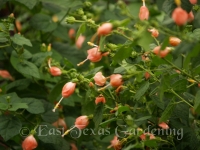
- September 5, 2016 - Turk’s Cap – A Texas Superstar and Hummingbird Favorite - An essential plant for the hummingbird southern migration is Turk’s Cap (Malvaviscus drummondii). This native perennial is very versatile in the garden, growing and blooming equally well in light shade or full sun ... Its heaviest blooming season is mid-summer through fall, and provides important feeding stations for ruby-throated hummingbirds as they fly south for the winter. Their bright red tubular flowers attract the eyes of both the hummers, butterflies and gardeners. (read more)
- August 4, 2016 - Humble Native Partridge Berry Makes Fine Groundcover - Just like a fine carpet or well-chosen tile flooring can dramatically enhance the appearance of any room in your home, so can a choice groundcover plant do for your home landscape. Selecting the right groundcover should be done wisely since an aggressive groundcover can quickly overtake a small area and become a nuisance rather than an asset. One of my favorite native groundcover plants is the lowly Partridge Berry (Mitchella repens).
 March 19, 2016 - Azaleas - Ideal Shrubs for East Texas Gardens - Tyler is well-known for its world-famous Rose Garden, which bursts into bloom in late April and early May. But it’s also no secret that Tyler draws tens of thousands of visitors a month earlier to drive the historic Azalea District to see the fabulous azalea displays, along with other spring-blooming flowers.
Azaleas have been part of the Tyler landscape for almost 100 years, but few realize that there is also a native azalea that grows along the sandy creeks in the woods surrounding Tyler - the Texas Azalea (Rhododendron oblongifolium). Regardless of whether you live on the Azalea Trail or in the country, you too can enjoy these beautiful and colorful plants in your own yard. Read more to see the great diversity of these wonderful plants.
March 19, 2016 - Azaleas - Ideal Shrubs for East Texas Gardens - Tyler is well-known for its world-famous Rose Garden, which bursts into bloom in late April and early May. But it’s also no secret that Tyler draws tens of thousands of visitors a month earlier to drive the historic Azalea District to see the fabulous azalea displays, along with other spring-blooming flowers.
Azaleas have been part of the Tyler landscape for almost 100 years, but few realize that there is also a native azalea that grows along the sandy creeks in the woods surrounding Tyler - the Texas Azalea (Rhododendron oblongifolium). Regardless of whether you live on the Azalea Trail or in the country, you too can enjoy these beautiful and colorful plants in your own yard. Read more to see the great diversity of these wonderful plants.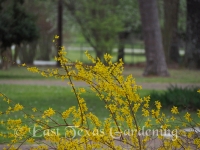 March 9, 2016 - Early Spring Color from Tough, Dependable Shrubs - As the grip of winter loosens, several shrubs burst into bloom, foretelling the promise of the coming spring. Here are three shrubs that flaunt their colors very early, before azaleas come into full bloom, then fade into the background for the rest of the year. These are also deciduous, meaning they will be bare sticks in the winter. Use them sparingly, strategically placing them so that when they are not in bloom they do not dominate the scene, but in spots where they will be easily seen attention getters.
March 9, 2016 - Early Spring Color from Tough, Dependable Shrubs - As the grip of winter loosens, several shrubs burst into bloom, foretelling the promise of the coming spring. Here are three shrubs that flaunt their colors very early, before azaleas come into full bloom, then fade into the background for the rest of the year. These are also deciduous, meaning they will be bare sticks in the winter. Use them sparingly, strategically placing them so that when they are not in bloom they do not dominate the scene, but in spots where they will be easily seen attention getters.- February 24, 2016 - Roses are Great for Beautifying Your Yard – But Be Alert for Rose Rosette Disease -
Roses have become more
 popular than ever with the development and promotion of vigorous, disease resistant shrub roses. I remember my father being quite smitten with Carefree Beauty (also known as Katy’s Road Pink) when it first came out in the late 70’s and early 80’s. This rose was extensively promoted to be carefree, and useful for massing and hedging. This was growing roses for a landscape effect rather than for the exhibition of highly bred hybrid teas, which had a well-deserved reputation of needing a much higher level of care, especially pruning. Then along came Knock Out at the turn of the century, and suddenly anybody could grow this tough, forgiving and floriferous rose. And it was planted everywhere!!
.... (read more)
popular than ever with the development and promotion of vigorous, disease resistant shrub roses. I remember my father being quite smitten with Carefree Beauty (also known as Katy’s Road Pink) when it first came out in the late 70’s and early 80’s. This rose was extensively promoted to be carefree, and useful for massing and hedging. This was growing roses for a landscape effect rather than for the exhibition of highly bred hybrid teas, which had a well-deserved reputation of needing a much higher level of care, especially pruning. Then along came Knock Out at the turn of the century, and suddenly anybody could grow this tough, forgiving and floriferous rose. And it was planted everywhere!!
.... (read more) - Feburary 18, 2016 - February Lawn Care Tips - I'm frequently asked after the first couple of warm days
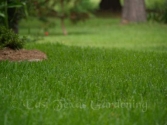 (usually in February), "When should I fertilize my lawn?" Maybe it's the advertisers' premature promoting lawn food to green up the grass. Or, maybe it's just the gardening bug in general. Or, perhaps are wanting to get a jump on weed control by laying down a weed preventer/fertilizer combo product. Whatever the reason, February is way too early to fertilize your grass.
(usually in February), "When should I fertilize my lawn?" Maybe it's the advertisers' premature promoting lawn food to green up the grass. Or, maybe it's just the gardening bug in general. Or, perhaps are wanting to get a jump on weed control by laying down a weed preventer/fertilizer combo product. Whatever the reason, February is way too early to fertilize your grass. - February 15, 2016 - Deciduous Magnolias - One of the classiest groups of trees for the southern landscape are
 the magnolias. Few trees say, “Spring is almost here!” as do the showy deciduous magnolias. This group of fine, ornamental small trees put on a display of colorful flowers long before the first leaf buds unfold. ... (read more)
the magnolias. Few trees say, “Spring is almost here!” as do the showy deciduous magnolias. This group of fine, ornamental small trees put on a display of colorful flowers long before the first leaf buds unfold. ... (read more) - February 9, 2016 -
Practical Rose Pruning for Best Blooming Results
- We can complain because rose bushes have
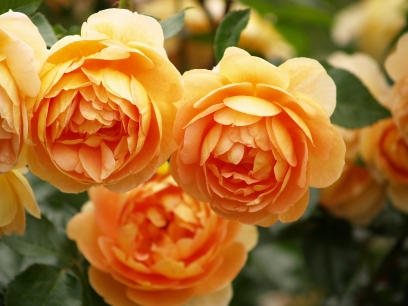 thorns, or rejoice because thorn bushes have roses.” (attributed many times on the internet to Abraham Lincoln, but apparently more accurately attributed to Alphonse Karr - still a good sentiment, no matter who originated the saying!)
Mid-February marks the beginning of the best time to prune roses in the Northeast Texas area. Valentine's Day is an easy way to remember when this gardening task should occur... (read more)
thorns, or rejoice because thorn bushes have roses.” (attributed many times on the internet to Abraham Lincoln, but apparently more accurately attributed to Alphonse Karr - still a good sentiment, no matter who originated the saying!)
Mid-February marks the beginning of the best time to prune roses in the Northeast Texas area. Valentine's Day is an easy way to remember when this gardening task should occur... (read more)
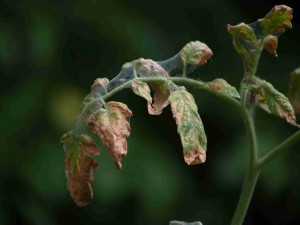
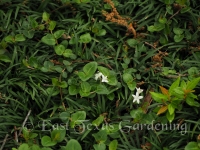
Come back frequently to this page to keep up with the latest posts/additions to this website, or subscribe to this page with an RSS feed. ![]() . I'll be adding articles to the Educational Resources Section of East Texas Gardening.
. I'll be adding articles to the Educational Resources Section of East Texas Gardening.
Another way to be notified is to ![]() my http://Facebook.com/easttexasgardening page where I will post new additions.
my http://Facebook.com/easttexasgardening page where I will post new additions.

